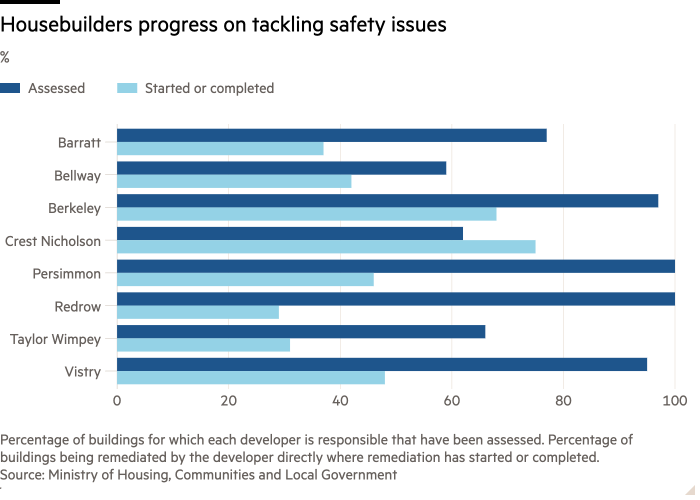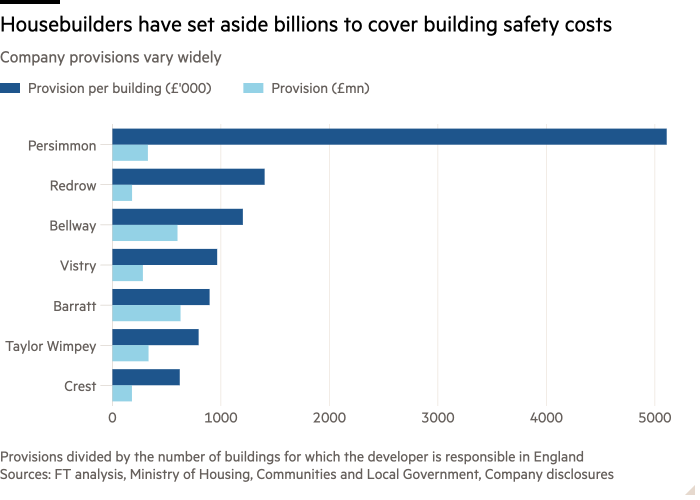
Unlock the Editor’s Digest for free
Roula Khalaf, Editor of the FT, selects her favourite stories in this weekly newsletter.
UK housebuilders will be given 18 months to start fixing dangerous cladding on blocks of flats under government proposals following the damning report of the Grenfell Tower inquiry.
The Ministry of Housing, Communities and Local Government has proposed a five-point plan it hopes to agree with big developers to tackle the slow progress on fixing fire safety issues in their buildings, according to a document seen by the FT.
Housebuilding bosses are due to meet deputy prime minister Angela Rayner later this month to finalise the plans, which could mean a financial hit for companies that have not yet set aside enough money to fix the problems.
In the wake of last month’s report into the 2017 Grenfell disaster, when dangerous cladding caused fire to spread up the west London tower block killing 72 people, Downing Street said it was considering criminal sanctions against businesses that fail to replace unsafe cladding.
Rayner said she was “astonished” how many companies had not yet started the work and pledged to speed it up.
The previous Tory government used the threat of withholding planning and building control approval for developers who did not agree to tackle the cladding crisis.
Under the Labour government’s new proposals, developers will have six months from the date the plan is agreed to finish assessing whether their buildings need remediation and a further 12 months to start work.
The housing ministry said it would present a “new remediation acceleration plan” before the end of the year.
“The pace of remediation has been too slow and we are urgently looking at all options to ensure residents no longer have to live in unsafe buildings,” a spokesperson said.
Thousands of tower blocks with building safety problems were identified in the aftermath of the Grenfell tragedy. But seven years after the fire, many residents are still waiting for confirmation that their building is safe, or have yet to see vitally important remediation work begin.
While they wait, residents have described the intense anxiety they feel living in potentially dangerous buildings. They also often face difficulty selling their properties, as well as high insurance and service charge costs.
Under the government’s proposal, the housing ministry would help deal with “belligerent” freehold building owners who hamper progress on fire safety works, and would “minimise avoidable delays” at the Building Safety Regulator “without compromising quality of oversight”.
Delays at the regulator, which has to sign off cladding works, has been a key complaint from the industry — alongside shortages of qualified fire engineers, contractors and materials.
Neil Jefferson, chief executive of the Home Builders Federation, which represents housebuilders, said: “Assessing buildings and commencing works requires permission from freeholders and managing agents [and] often needs sign-off from a newly created Building Safety Regulator that is struggling to deal with the number of applications received.”
Speeding up remediation could impose a significant financial burden on some big housebuilders at a time when the government is also keen to see them accelerate construction after a two-year housebuilding downturn.
There are big differences in how much progress large listed housebuilders have made and the amounts of money they have already set aside to pay for remediation, according to government data and company reports.

Aynsley Lammin, analyst at Investec, said it would be “taken negatively by the market if any government action led to companies revealing that some buildings for which they are liable, have not yet been [financially] provided for”.
He added that having to move faster could increase the costs, but that dealing with the issue quickly would ultimately be positive for companies.
Persimmon and Redrow — which was recently taken over by Barratt — have assessed 100 per cent of the buildings they are responsible for, and Berkeley and Vistry have assessed over 95 per cent.
In contrast, Crest Nicholson and Bellway have assessed around 60 per cent and Taylor Wimpey has covered 66 per cent.
Taylor Wimpey said its own qualified staff had assessed all the relevant buildings, but that the official figures only reflect those with independent assessments.

Bellway said remediation is “often complex and dependent on certain factors outside our control” and that companies obligation to report figures to the government “can be subject to interpretation”.
Developers said they have tried to deal with the highest risk buildings first, so some of the remaining buildings will require less work.
Berkeley Group, which specialises in large buildings in London, declined to say how much money it has set aside.